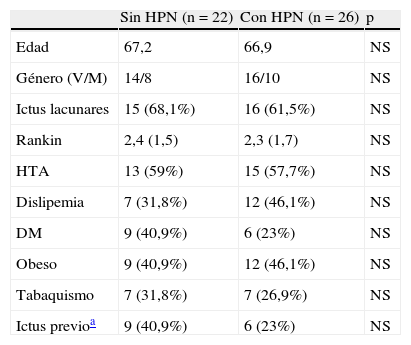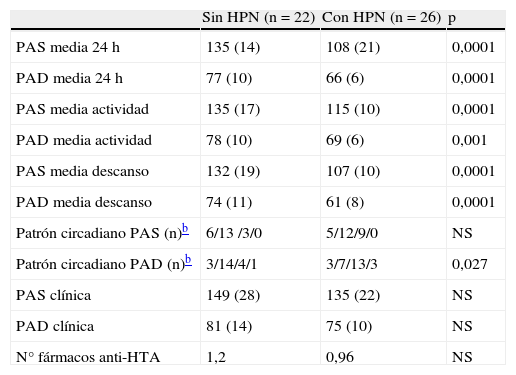El tratamiento de la hipertensión arterial constituye en la actualidad un pilar fundamental en las estrategias de prevención secundaria del ictus. No obstante, hoy en día no hay unanimidad en las cifras de presión arterial (PA) objetivo en prevención secundaria, y existe controversia sobre si el tratamiento antihipertensivo comprometería la perfusión cerebral de estos pacientes. El objetivo de este estudio es describir y analizar la presencia de hipotensión nocturna (HPN) en pacientes con ictus reciente a través del análisis de la monitorización ambulatoria de la PA (MAPA).
Material y métodoCuarenta y ocho pacientes consecutivos que acudieron a revisión al cabo de 6 meses tras un ictus fueron incluidos en el estudio. La MAPA de 24h se llevó a cabo mediante el monitor Spacelab 90207. Se consideraron episodios de HPN aquellos valores en los que la PA sistólica era menor de 100 mmHg. Posteriormente se compararon los pacientes con HPN frente a los que no la presentaron mediante el programa estadístico SSPS18,0.
ResultadosSe estudiaron 30 varones y 18 mujeres, de edad media 68±11 años. En 26 pacientes, el 54,2%, se evidenciaron episodios de HPN. No existieron diferencias significativas entre las características demográficas, tipo de ictus y factores de riesgo entre ambos grupos.
Con relación a los valores de PA, los pacientes con HPN presentaron PA media de 24 horas, PA media en actividad y PA media en descanso inferiores de forma significativa. Además el grupo con HPN presentó mayor número de sujetos con patrón dipper, aunque solo fueron estadísticamente significativas en los valores de PA diastólica, sin que existieran diferencias significativas en las cifras de PA en consulta, ni en el número, tipo o forma de administración de los fármacos antihipertensivos utilizados en cada grupo.
ConclusionesLos episodios de HPN en los pacientes con ictus recientes son frecuentes y difíciles de detectar con los valores de PA en consulta. Es necesario replantear los objetivos de PA en prevención secundaria en sujetos con ictus previo, dado que posiblemente estemos sometiendo a nuestros enfermos a un mayor riesgo de episodios de HPN e hipoperfusión cerebral.
Treatment of arterial hypertension is currently a fundamental mainstay in secondary stroke prevention strategies. However, at present there is no unanimity regarding target blood pressure (BP) levels in secondary prevention. Furthermore, controversy exists on whether blood pressure lowering treatment would affect the cerebral perfusion of these patients. This study has aimed to describe and analyze the presence of nocturnal hypertension (NHT) in patients with recent stroke through the analysis of ambulatory blood pressure monitoring (ABPM).
Material and methodForty-eight consecutive patients who came for checkup 6 months after a stroke were enrolled in the study. The 24-hour ABPM was conducted using the Spacelab 90207 monitor. Episodes of NHT were considered to be those in which the systolic BP was less than 100mm Hg. After, the patients with NHT were compared with those who did not have it using the SSPS 18.0 statistical program.
ResultsA total of 30 men and 18 women, mean age 68±11 years, were studied. Of the 26 patients, evidence of NHT episodes was observed. There were no statistical differences between the demographic characteristics, type of stroke and risk factors between both groups. In relationship to the BP levels, patients with NHT had significantly lower mean 24 hour BP, mean PB with activity and mean resting BP. Furthermore, in the NHT group, there was a greater number of subjects with dipper pattern, although there was only statistical significance in the dyastolic BP levels, there not being significant differences in the BP levels in the doctor's office, or in the number, type or form of administration of the antihypertensive drugs used in each group.
ConclusionsNHT episodes of patients with recent stroke are frequent and difficult to detect with the BP levels in the doctor's office. BP targets in secondary prevention in subjects with previous stroke must be redefined, given that we may be subjecting our patients to a greater risk of NHT episodes and cerebral hypoperfusion.
Artículo
Comprando el artículo el PDF del mismo podrá ser descargado
Precio 19,34 €
Comprar ahora







